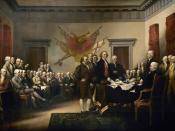Leading up to the eve of the Revolution, Americans had developed strong sense of nationalism often geared more towards their country than just to their states. On a large part, they saw the value in unifying with each other in become stronger in defense against Britain. A consequence of this unification of states was a unification of people in terms of culture and ethnicity. The colonists spread their messages of coalition through newspapers, letters, and other forms of writing. Not all Americans thought this way, however. There were always those who believed that the Mother Country was to remain at her rightful place of dominancy over her Colonist children, and that living conditions would not improve if America received independence.
The printing press was already invented and popularized when colony states first began considering the benefits of joining with one another. Because of the pressÃÂs efficiency and relative inexpensiveness, newspapers were made highly popular, and many Americans read a great deal of what was happening throughout their own colony, and most importantly, throughout all the other colonies.
Through these newspapers, revolutionists often conveyed their messages of union to their readers, possibly the most famous of which is the illustration of the snake that was cut up into several segment, with a colonyÃÂs abbreviation atop each segment. Written under the snake is ÃÂJoin, or Die.ÃÂ Other examples of written works of American unity are the Continental CongressÃÂs Declaration for the Causes of Taking up Arms, in which the Congress claims that the colonies must unite in order to protect themselves from England (though it also noted that the goal was not to separate from England), and Richard Henry LeeÃÂs letter to Arthur Lee, in which he writes about how in 1774, the colonies were uniting themselves for protection against EnglandÃÂs corruptive ways. Not all colonists agreed that separation from England was the right way to go. There were also always those who wrote negatively on the topic of separation. People like Mather Byles, who wrote to Nathaniel Emmons expressing his fears that a government in America would be just as corrupt as the one in England, used writing in order to influence people to not have a revolution.
The colonists chiefly came from various countries of Europe. Back in Europe, they would all have prejudices towards members of other European countries, such as the constant hatred between the French and the English, but in America, they became homogeneous. The populations of all of Europe mixed so much that those seemingly innate prejudices that they used to have towards one another began to melt away. They intermarried and all worked together, so social rank was often roughly equal in communities. Such intermingling of Europeans was described by Hector St.John Crevecoeur in Letters from an American Farmer. Perhaps it was the fact that the states were composed of mixed ethnicities that got the colonists of each state to develop a kinship with the others, and to develop a nationalism geared toward America as opposed to toward just one state. This is something that might not have happened if each state had a distinct ethnicity of people living in it, for the colonists of various states would have had much less in common with one another and much larger differences in ideology. This nationalism was exemplified very well when members of 5 different colonies donated food, money, and provisions to residents of Boston, who were suffering terribly due to the closing of their dock by the British.
Feelings of national unity appeared in Colonists` minds far before the start of the Revolution. In fact, it was these feelings that led to the Revolution. Though not Colonists wanted to separate from England, a majority of them did feel a common notion of living in the united States, not just in a single state. This unity led to the mixing of a huge range of populations, and a new cultural identity: American.
bibliography:America Past and Present, AP* Edition, Revised Seventh EditionWikipedia contributors. "American Revolution." Wikipedia, The Free Encyclopedia. Wikipedia, The Free Encyclopedia, 1 Mar. 2010. Web. 2 Mar. 2010.






Hi.
I am in college right now, however I remember DBQ's for AP US History and AP Government and this has been well written with great detail. The AP graders come May (test month) will want to see more strong verse and organization however for the perfect five on the AP exam. Good luck!
0 out of 0 people found this comment useful.